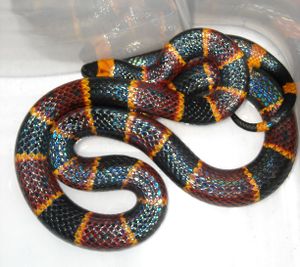We need you! Join our contributor community and become a WikEM editor through our open and transparent promotion process.
Snake bites
From WikEM
(Redirected from Snake Bites)
Contents
Background
- An average of 5000 native venomous snakebites are reported to US poison centers annually[1]
- In the United States, snake bites can be organized into Crotaline (Pit Vipers) and Elapidae (Coral Snakes)
- Crotalidae family also includes rattlesnakes, Sistrurus and Agkistrodon species (water moccasins and copperheads).[2]
- Risk Factors: "The 'T's" Testosterone, Tequila, Tshirt, Tattoos, Toothless, Teasing, Trailer park, Truck
Venom
- Snake venom is a mixture of proteins, peptides, lipids, and metal ions.
- Many bites can be "dry bites" where not venom is released, about ~1/4
Clinical Features
- Local injury - punctures marks from fangs not always visible, erythema, and edema
- Ooze at fang mark reliable sign of envenomation
- Nausea/vomiting
Differential Diagnosis
Envenomations, bites and stings
- Mammalian bites
- Closed fist infection (Fight bite)
- Hymenoptera stings (bees, wasps, ants)
- Spider bites
- Scorpion envenomation
- Marine toxins and envenomations
- Snake bites
Evaluation
- Clinical Diagnosis
Management
Local Care
- Do:
- Immobilize limb in a neutral position
- Remove all jewelry
- Do not:
- Attempt to suck out the venom
- Place the affected part in cold water
- Use a tourniquet or wrap
Supportive care
- IVF and pressors if needed for hypotension
- Blood components rarely needed
- Treatment mainly depends upon the presence of an envenomation
- Indications:
- Progression of local injury - pain, swelling, ecchymosis
- Coagulopathy - elevated PT/PTT/INR, low fibrinogen, thrombocytopenia
- Systemic effects - hypotension, altered mental status, nausea and vomiting, paresthesias
- Always provide supportive care and treat local effects of any wounds
- Irrigation of the wound is necessary regardless of the type of snake bite
- Debridement and removal of devitalized tissue may be necessary for severe bites
- Evidence does not support use of empiric antibiotics to prevent secondary infection [3]
Antivenom
- Snake specific treatments depend upon Coral snake or Pit viper envenomations
Disposition
- All snake bites with evidence of envenomations should have a period of observation and possible hospitalization
- Old bites can be assessed an discharged if no evidence of envenomation.
See Also
References
- ↑ Seifert SA et al. AAPCC database characterization of native U.S. venomous snake exposures, 2001-2005. Clin Toxicol (Phila). 2009;47: 327–335.
- ↑ Goldfranks Toxicology - Envenomations
- ↑ Gold B.. Bites of venomous snakes. N Engl J Med. 2002;347(5):347-56.


